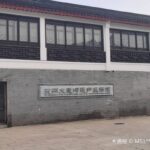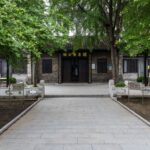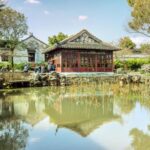Liu Rushi’s Tomb is located at the southern foot of Yushan Mountain, approximately 100 meters west of Qian Qianyi’s tomb, and is a municipal cultural relics protection unit. The existing tomb, facing south and backed by the mountain with a lake view, covers an area of 243 square meters with a burial mound height of 1.1 meters. It is enclosed by a circular wall and features a limestone stele erected after the reconstruction, inscribed with ‘The Tomb of Lady Hedong.’ In 1957, it was declared a provincial cultural relics protection unit and was adjusted to a county-level unit in 1982, and is now a municipal cultural relics protection unit.
Liu Rushi (1618-1664), originally surnamed Yang, named Ai, and styled Yinglian. Later, she changed her surname to Liu, named Yin, also known as Shi, styled Rushi, and also known as Tengwu, and was called Woshen Jushi. She was a famous talented woman and poet with national integrity at the end of the Ming and the beginning of the Qing Dynasty. Originally from Jiaxing, Zhejiang, she later moved to Wujiang. As a child, she was abducted and sold into a brothel, fortunately finding refuge with the famous courtesan Xu Fo of the Guijia Court in Shengze, Wujiang. In the thirteenth year of the Chongzhen era (1640), she admired the poetic talent and knowledge of Qian Qianyi, who had been a leader in the literary world for decades, and sailed to Changshu to meet him. She later married him as a concubine and lived in seclusion in Qian’s Banyetang (the site is now on Yushan North Road). With their matching beauty and white hair, they enjoyed each other’s company, and were referred to by their contemporaries as a ‘divine couple.’ In the third year of the Shunzhi era (1646), after the collapse of the ‘Hongguang’ regime, Qian Qianyi lost his integrity by opening the city to surrender, and Liu had strongly advised him to commit suicide for the country, but she failed. She herself plunged into a pond in an attempt to die for her country but survived. After the fall of the ‘Hongguang’ southern capital, Qian’s family moved north as required, but Liu refused to go and stayed alone in Jinling. She strongly encouraged and participated in Qian’s support for anti-Qing and pro-Ming activists such as Huang Yuqi and Zheng Chenggong, demonstrating her unwavering national spirit and was praised as a ‘heroine.’ After Liu’s death, she was buried by Qian Qianyi’s disciples, including Wang Mengding, in the courtyard of Qiushui Pavilion at Qian’s other residence, Fushui Mountain Villa. The original Fushui Mountain Villa no longer exists, and the current Fushui Mountain Villa in the Xianlv Scenic Area is a replica and not on the original site. Opening hours are from 8:00 to 16:00, with last admission at 16:00.Liu Rushi’s Tomb
Liu Rushi’s Tomb is located at the southern foot of Yushan Mountain, approximately 100 meters [...]









